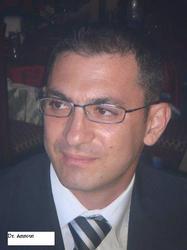SPECIALIZED and CONSULTIVE CENTER of FORENSIC MEDICAL SCIENCES in THE M.E. / LEBANON
S.C.C.F.M.S. Founders.
Dr. Abdul Rahman Annous, pathologist - Medical Expert.
Dr. Mohtassem EL-Samad, General Manager.
Dr. Bilal Sablouh, Forensic Expert - Balist.
TARGETS & AIMS of the S.C.C.F.M.S.
Our center aims at filling the gap that exists in Lebanon because universities, government offices and even medical sectors do not have a center that combines the different and various fields of forensic science. Our modest attempt was followed by creating an awareness campaign on TV, radio and newspapers where our center specialists were hosted on major TV talk shows and were featured in local newspapers discussing the problems, challenges and future directions of forensic medicine. After the tragic assassination of our late prime minister Rafic Harriri in February 2005 and the series of bombs that targeted prominent politicians and innocent people, Lebanon has witnessed a radical change. For the first time, international experts have highlighted the weakness and the absence of professionalism and the technical expertise in the field of forensic medicine and criminology both in the legal system and the Lebanese security forces. Therefore, we were aware that there is an utmost need to build new units and departments that would deal with terrorism issues and would uncover the truth behind all the terrorist attacks and threats that are facing our country. We will benefit tremendously from our expertise and professional experience and relationships to assist in building such an infrastructure in our emerging democracy Lebanon. We are honored to declare our new department of anti-terrorism crime ,we will arrange issues on how to develop this department in order to serve every cause internationally.
Sincerely yours,
Dr. Abdul Rahman Annous
The Names of Ladies and Gentlemen ,Experts and Doctors Consultants Contracted with the S.C.C.F.M.S.:
Prof. Fouad Ayoub, Forensic Dentist.Stamothology.
Pres. Arz Al-Alam. Judge.
Dr.Mohamed El-Jiser. Radiologist.
Dr .Haitham El-Samad. Neurosurgery .
Dr.Khaled Al-Hussain. Rheumatology.
Dr.Samih Barake. Anesthesiology.
Dr.Albert Azar. General Laboratory.
Dr.Noha Fatfat. Gynecology-Obstetrics.
Dr.Hashem Al-Masri. Gynecology-Obstetrics.
Dr. Nazih Khayat. Surgery.
Dr. Bassam Issa . Cardiology.
Dr. Antoine Hayek. Pulmonologist.
Dr. Mustafa Alloush. Surgery.
Phd. Fouad Dabbousi. Molecular Biology.DNA.
Dr. Hatem Al-Monla. Cardio-Surgery.
Dr. Yemen Hwalla. Pediatrics.
Dr. Nataly Yenni.
Dr.Walid Sawalhi.
Dr. Yossef Al-Zhobi. Forensic Expert.
Lawyer. Rashid Derbas.
Lawyer. Mohammad Al-Mourad.
Lawyer. Nawaf Al-Mourad.
Text expert. Ret.capt. Nasr allah Fayad.
Dr. Marwan Shdid. Forensic Toxicology.
Dr. Tatiana Annous. Pediatrics.
Dr.Bilal Sablouh. Forensic Expert.Balist.
Dr. Souheil Raad.
Dr. Mohammed El-Assaad.
Dr. Nadim Al-Ayoubi.
Dr. Louis Ayoub.
Dr. Sabri Tatari.
Dr. Tamim Darwish.
Mr. Nadim Darwish.
LECTURE by Dr. ANNOUS & Dr.SABLOUH
The Direct and Indirect Causal Relation between Injury and Death
by Dr. Abdul Rahman Annous and Dr. Bilal Sablouh,
- The cause
- The patient's situation
- The motive
Low Temperature Cause of Death
The Effects of Low Temperature on the Human Body and Death
by
